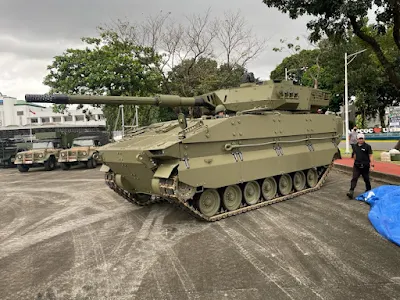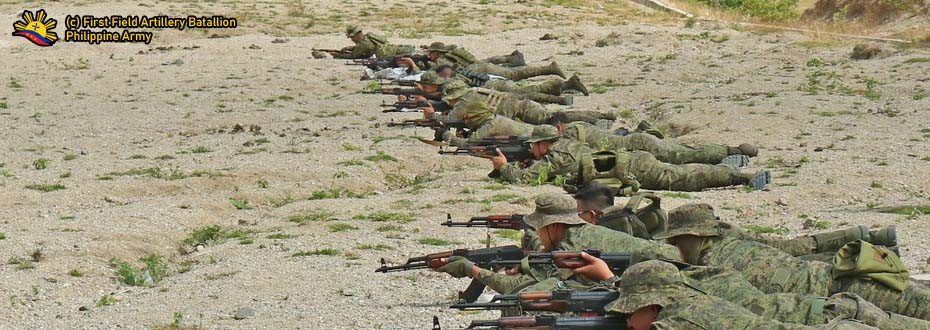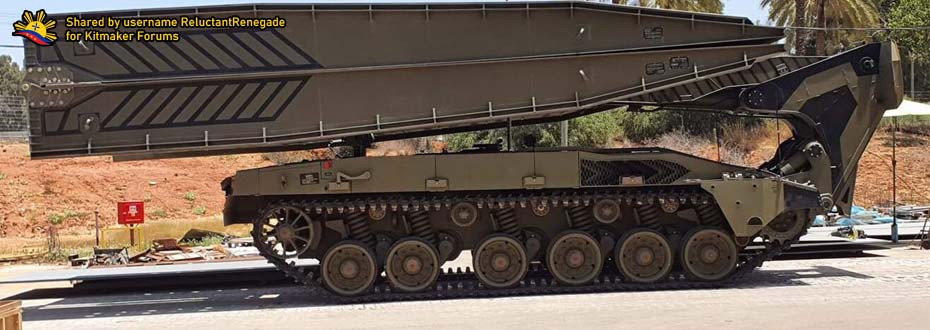Shaldag-V Fast Attack Interdiction Craft
(Also known as the Nestor Acero-class Fast Attack Interdiction Craft-Missile or FAIC-M).
 |
The newly commissioned Shaldag-V vessels named BRP Nestor Acero and BRP Lolinato To-Ong.
Image Source. |
1. Israel
Material Type: Shaldag
Weapons Description: Fast Attack Craft (FAC)
Number ordered: 4
Year ordered: 2021
Year delivery: N/A
Number delivered: N/A
Description: Part of PHP10 [Billion] 'Fast Attack Interdictor Craft-Missile' [program], produced under licence in Philippines; delivery planned from 2023.
2. Israel
Material Type: Shaldag Mk-5
Weapons Description: Patrol Craft
Number ordered: 5
Year ordered: 2021
Year delivery: 2022
Number delivered: 5
Description: [It is] part of PHP10 [Billion] 'Fast Attack Interdictor Craft-Missile' [Acquisition Program].
3. Israel
Material Type: SPIKE-NLOS
Weapons Description: [It is a] Ship-to-Ship Missile/Anti-ship [Missile weapons munition].
Number ordered: 50
Year ordered: 2021
Year delivery: N/A
Number delivered: N/A
Description: [It is] for 4 Shaldag Mk-5 Fast Attack Craft.
The list provided by SIPRI for the Shaldag-V Fast Attack Interdiction Craft-Missile or FAIC-M Acquisition divides itself into two parts. The first part is the five (5) units of the Shaldag-V produced from the Israel Shipyards facility in Haifa, while the second part will be the local production units under license through the
Philippine Navy shipbuilding facility in Cavite.
Aside from this development, the Philippine Navy
signifies its intention to buy at least fifteen (15) more Shaldag V or the Nestor Acero-class Fast Attack Interdiction Crafts, on top of the nine orders that the leadership made as these vessels are in need for the Philippine Navy in patrolling its littoral waters under the naval service branch’s Littoral Combat Force as it augments the unit’s
Multipurpose Attack Crafts or MPAC, as the fleet decommissioned its old, World War 2-era vessels years ago with no immediate replacement.
Just recently,
the Philippine Navy commissioned two of the said Shaldag V Fast Attack Interdiction Crafts, namely the BRP Nestor Acero (PG-901) and BRP Lolinato To-Ong (PG-902), making it official that the Philippine Navy operates such Israeli-made fast attack crafts into its fleet.
Read more on these related PDA articles on Shaldag Fast Attack Crafts in the following links below.
GAIA AMIR MRAP (Mine Resistant Ambush Protected)
1. Israel
Material Type: Amir
Weapons Description: Armored Personnel Carrier/Armored Personnel Vehicle
Number ordered: 14
Year ordered: 2018
Year delivery: N/A
Number delivered: N/A
Description: [These are armored vehicles for the Philippine National Police - Special Action Force] or for PNP-SAF (Police).
This is the first weapons platform in this SIPRI list that involves an armored vehicle intended for the Philippine National Police, specifically for the
Special Action Force or SAF, the law enforcement agency's Elite Special Forces. Let us just take note that the Philippine National Police is under the
Department of Interior and Local Government, and not the Department of National Defense where the Armed Forces of the Philippines fall under, as we usually discuss here.
The AMIR MRAP is a product of GAIA Automotive Industries,
whereby they depict it as a multi-purpose 4x4 mine protected armored vehicle that can carry SAF troopers up to at least 12 people, with a protection up to level 3, a Gross Vehicle Weight or GVW up to 14 tons, and a capability of carrying a payload up to 3.4 tons. For starters, an MRAP or a
Mine Resistant Ambush Protected Vehicles are platforms that provide high mobility and survivability rates for troops riding onboard, as it mitigates threats from small arms fire, improvised explosive devices or IEDs, mines, and at some instances, rocket-propelled grenades or RPGs.
This acquisition makes sense from the counterinsurgency point of view, as the country is still facing threats coming from communist bandits that are fighting for armed struggle in the mountains or the extremists on the island of Mindanao that the SAF troopers face the danger from getting killed from ambushes, dwindling the number of personnel serving in a unit.
Update: At the time this article has published, the contract for the delivery of these MRAPs has canceled by the end-user, citing delays on the delivery with the pandemic playing a factor in their compliance in the agreement. Check
this database from another defense page for more information.
Elbit ORCWS (Overhead Remote-Controlled Weapons System)
1. Israel
Material Type: ORCWS
Weapons Description: APC Turret
Number ordered: 44
Year ordered: 2018
Year delivery: N/A
Number delivered: N/A
Description: [The turrets are] for [the] modernization of 44 M-113A2 Armored Personnel Carriers.
As part of upgrading the bulk of the Philippine Army's inventory of M-113 Armored Personnel Carriers into active fully capable Armored Fighting Vehicles or AFVs, Israel's Elbit Systems Ltd., has installed its sophisticated Overhead Remote-Controlled Weapons System, or ORCWS, that does not require a crew to man the weapon onboard which reduces the risk of getting shot by the enemy from exposed weapons fire.
The Elbit ORCWS also comes with a covered version called the
UT-25 or the Unmanned Turret, in which the Philippine Army also has this type of configuration installed onboard some of its M-113 Infantry Fighting Vehicles. This actually augments other armored vehicles of the Philippine Army that undertook weapons installation upgrades, such as the FNSS ACV-300 Armored Infantry Fighting Vehicles or AIFV that now comes with Saber-25mm one-manned turret (also on this list, discussions below).
As the Philippine Army’s Armor ‘Pambato’ Division gets modernized by receiving more modern equipment while upgrading its existing armored vehicles, it is a welcoming development for the organization to have remote-controlled weapons systems installed onboard the M-113s as it provides additional firepower support for the ground troops to fight opposition forces (OPFOR) in combat zones, especially against communist and extremist bandits.
RAFAEL Advanced Systems Ltd. SPYDER-MR Ground-Based Air Defense System (GBADS)
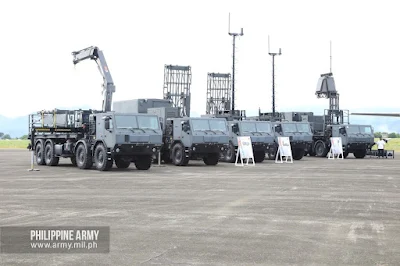 |
The Philippine air force’s newest air defense systems.
Image Source. |
1. Israel
Material Type: I-Derby ER
Weapons Description: BVRAAM
Number ordered: 125
Year ordered: 2019
Year delivery: 2022
Number delivered: 75
Description: For SPYDER-MR SAM Systems.
2. Israel
Material Type: Python-5
Weapons Description: BVRAAM
Number ordered: 125
Year ordered: 2019
Year delivery: 2022
Number delivered: 75
Description: For SPYDER-MR SAM Systems.
3. Israel
Material Type: SPYDER-MR
Weapons Description: SAM system
Number ordered: 3
Year ordered: 2019
Year delivery: 2022
Number delivered: 2
Description: [Philippine Air Force’s] PHP6.4 Billion ($125 m) deal, [A SPYDER-MR variant] Philippines Air Defense System version, delivery planned 2022-2023.
The SPYDER-MR Ground-Based Air Defense System (GBADS) from Israel’s RAFAEL Advanced Systems Ltd., served as the Philippine Air Force’s very first decent air defense system that is an integral part of the country’s effort of implementing the Philippine Air Defense Identification Zone or PADIZ.
The Philippine Air Force sees the SPYDER-MR Ground-Based Air Defense System as an integral part of the
air service branch’s efforts to secure critical defense installations, government centers, key business districts, electric power plants, water reservoirs, and others. Also, another thing to take note about the SPYDER-MR system is that
it’s capability comes with a maximum of 50 kilometers and an altitude of fire off around 16 kilometers, or in a borderline between the Earth’s
troposphere and stratosphere layers.
Another thing to take note is that the SIPRI list only provides two batteries of SPYDER-MR GBADS so far, with the
third one getting delivered into the country some time within this year, putting the whole acquisition project for the Ground-Based Air Defense System of the Philippine Air Force into completion.
Read more on these related PDA articles on the SPYDER-MR Ground-Based Air Defense System (GBADS) in the following links below.
J/FPS-3 Air Search Radar
1. Japan
Material Type: J/FPS-3
Weapons Description: air search radar
Number ordered: 4
Year ordered: 2020
Year delivery: 2022
Number delivered: 1
Description: [Intended for the] Php 5.5 Billion ($104 Million) Air Surveillance Radar System Program
Aside from the GBADS or Ground-Based Air Defense Systems that the Philippine Air Force received from Israel like the SPYDER-MR from RAFAEL Advanced Systems Ltd., another military platform that is part of implementing the Philippine Air Defense Identification System or PADIZ that has found in the 2022 SIPRI list is the Japanese
J/FPS-3 air search radar.
The radar systems are part of the Horizon 2 Air Surveillance Radar Systems acquisition project, in which it comes with a contract intended for Mitsubishi Electric (who is the winning bidder for the project) to provide three fixed long range and one mobile radar systems as the country aims to get more radar to get an almost 100% radar coverage across the country,
beyond Area Awareness 3 boundaries of the current Philippine Air Defense Identification Zone.
As the Philippine Air Force aspires to get the Philippine Air Defense Identification Zone to get at least to Area Readiness 1 or 100% coverage of the Philippine airspace over the archipelago of the Republic, the
J/FPS-3 air search radars serve as an additional capability for the air service branch to scan the country’s airspace from unauthorized intruders, as it augments its current air defense systems and eventually its desire to have sophisticated aviations technology like the Multi-role Fighter jets.
Philippine Navy’s Jose Rizal-class Frigates (HHI HDF-2600)
1. South Korea
Material Type: C-STAR
Weapons Description: anti-ship missile
Number ordered: 15
Year ordered: 2017
Year delivery: 2022
Number delivered: 15
Description: [Intended] for [the Philippine Navy’s] HHI [HDP]-2600 (Rizal) Frigates
2. South Korea
Material Type: K-745 Blue Shark
Weapons Description: ASW Torpedo
Number ordered: 25
Year ordered: 2021
Year delivery: N/A
Number delivered: N/A
Description: For HHI-2600 (Rizal) frigates, selected but possible not ordered by end-2021
While the delivery of the second Jose Rizal-class Frigate, the BRP Antonio Luna of the Philippine Navy
took place in February 2021, it was not until a year later in 2022 that several of its subcomponents have delivered into the country for the warships to be more capable, especially in terms with the firepower it carries.
One of the add-ons highlighted on the list is the C-STAR anti-ship missile from South Korea,
whereby it has installed on both BRP Jose Rizal (FF-150) and BRP Antonio Luna (FF-151) somewhere in May 2022, just months before BRP Antonio Luna set sail to Pearl Harbor in Oahu, Hawaii for
the year’s Rim of the Pacific (RIMPAC) multilateral exercises led by the United States Pacific Fleet. The
SSM-700K ‘Haeseong’ C-Star Missile is South Korean Navy’s mainstay anti-ship missile system made by Hanwha Systems that has the weight of 718 kilograms, a missile speed of 1,010 km/h, and a missile range of 150 to 320 kilometers.
Both the SSM-700K C-Star anti-ship missile and the K-745 Blue Shark anti-submarine torpedoes are from South Korea, similar to the Jose Rizal-class Frigates made by Hyundai Heavy Industries, and both of the weapons makes these warships further armed to the teeth, currently being the most capable ships of the Philippine Navy at the time this article published.
Read more on these related PDA articles on the Jose Rizal-class Frigates, along with the SSM-700K C-Star anti-ship missiles and the K-745 Blue Shark Torpedoes in the following links below.
Philippine Navy’s HDC-3100 Corvettes
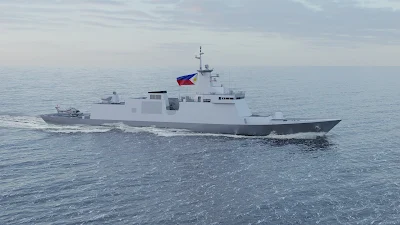 |
Prospect design of the Corvette Acquisition Project.
Image Source. |
1. Israel
Material Type: M-2258 ALPHA
Weapons Description: air search radar
Number ordered: N/A
Year ordered: 2022
Year delivery: N/A
Number delivered: N/A
Description: For HHI frigates from South Korea
2. South Korea
Material Type: HHI Corvette
Weapons Description: Frigate
Number ordered: 2
Year ordered: 2021
Year delivery: N/A
Number delivered: N/A
Description: [It is a] Php 28 Billion ($556 Million) deal
Aside from the Frigates, the Philippine Navy is also pursuing the procurement of additional corvettes, which, ironically, are more capable than what the Jose Rizal-class Frigates currently offer in terms of firepower and the number of sensors installed onboard a vessel.
From the design standpoint, the depiction of the Corvettes being more capable than the Jose Rizal-class Frigates definitely make sense, as the HDP-3100 design itself is a derivative of the HDF-2600 that the Jose Rizal-class Frigates are based on. Apparently, the new corvettes will be capable of carrying eight (8) LigNex1 SSM-700K C-Star Anti-Ship missiles in a 4x2 missile configuration, whilst having other weapons suite such as the usual 76mm Oto Melara Super Rapid Gun, launchers for K745 Blue Shark Torpedoes, and other components such as the 16-cell MBDA-MICA Vertical Launch System.
As to the acquisition project’s current progress, it is more likely that the plans of initiating
the steel cutting for the two Philippine Navy corvettes in May and November 2023 may push through, with the delivery date slated by the year 2025 to 2026, adding the number of sophisticated warships that the Philippine naval fleet have, operated by the Navy’s Offshore Patrol Force unit.
Read more on these related PDA articles on the HDC-3100 Corvettes that the Philippine Navy is about to receive in the following links below.
Philippine Navy’s Additional Pohang-Class Corvette (Ex-ROKS Andong, PCC-771)
Plus munitions for the BRP Conrado Yap
1. South Korea
Material Type: Pohang
Weapons Description: Corvette
Number ordered: 1
Year ordered: 2021
Year delivery: N/A
Number delivered: N/A
Description: Second hand, aid
(Additional Information)
2. South Korea
Material Type: K-745 Blue Shark
Weapons Description: ASW Torpedo
Number ordered: 15
Year ordered: 2022
Year delivery: N/A
Number delivered: N/A
Description: For Pohang (Conrado Yap) corvette.
When the
BRP Conrado Yap (PS-39) has turned over to the Philippine Navy from its former service within the Republic of Korea Navy (South Korea)
last 2019, an idea of adding more Pohang-class Corvettes to the fleet immediately comes into mind as the South Koreans still have a handful of such ships in service that may still have the possibility to end up into foreign users like the Philippines.
That possibility came true in January 2022, when South Korea announced a turn-over of a Pohang-class Corvette to the Philippine Navy,
with its former name being the ROKS Andong (PCC-771). The said ship is actually the newer Flight IV variant of the Pohang class, in which it goes differently to the ex-ROKS Chungju (PCC-762), or what is now BRP Conrado Yap (PS-39), as this ship belonged to the earlier Flight III variant of the Pohang-class.
As there may soon be at least two Pohang-class Corvettes serving in the Philippine Navy, once the ex-ROKS Andong (PCC-771) formally turned over by South Korea to the Philippine Naval fleet, it may not be surprising if another idea of adding such vessel raises up several years down the road, as long as there remains a fleet of such ships from the South Korean Navy being up for grabs after their retirement.
Read more on a related PDA article on additional Pohang-class Corvettes for the Philippine Navy from 2019 on this link right here.
Philippine Navy’s HDP-2400 Offshore Patrol Vessels
1. South Korea
Material Type: HHI-2400
Weapons Description: Offshore Patrol Vessel
Number ordered: 6
Year ordered: 2022
Year delivery: N/A
Number delivered: N/A
Description: $573 million deal, planned by 2028
The Philippine Navy’s Offshore Patrol Vessel Acquisition Project is the third project that the South Korean shipbuilding firm Hyundai Heavy Industries secured a contract on as the winning bidder, after the Frigate Acquisition Project that produces the Jose Rizal-class Frigates and the currently implementing Corvette Acquisition Project with the HDC-3100 design being the one in use for the construction of the warships.
Hyundai Heavy Industries’ design offer for the Philippine Navy’s Offshore Patrol Vessel Acquisition Project actually derives itself from the initial
HDP-1500 offshore patrol vessel design concept, although modifications changes have made to meet the requirements for the project, such as increasing its overall tonnage and its overall size that might allow for future upgrades to get installed onboard the vessels upon the discretion of the end-user.
Apparently, while the initial design comes from the derivative of the HDP-1500 design and the Hyundai Heavy Industries submitted the HDP-2400 design as given on the list, this same South Korean shipbuilder actually give modifications, again, this time in terms to its overall tonnage when they lower it from 2400 tons down to just 2200 tons,
with the design now called ‘HDP-2200+’ Offshore Patrol Vessel concept.
While the overall tonnage changed, there are no modifications regarding the overall size as presented to the HDP-2400 design, as it remains to be that same 94-meter vessel offered, with 14.3 meters being its overall beam (width) and still can provide the same space for future upgrades to get installed on the ships.
Read more on these related PDA articles on the HDP-2400 Offshore Patrol Vessels that the Philippine Navy is about to receive in the following links below.
SAAB Sea Giraffe AMB Radar
1. Sweden
Material Type: Giraffe AMB
Weapons Description: Air Search Radar
Number ordered: 2
Year ordered: 2018
Year delivery: 2022
Number delivered: 2
Description: [SAAB’s] Sea Giraffe AMB version, for modernization of 2 Hamilton OPV, [coming] from [the] US Production Line.
Another thing to note for is the upgrades that the Philippine Navy’s Del Pilar-class Offshore Patrol Vessels received since the BRP Gregorio del Pilar (PS-15)
arrived in the country in 2011, when it was still the most sophisticated warship that the naval service branch ever received during that time, and the Revised AFP Modernization Program was still a concept.
These said upgrades
only cover the first two Del Pilar-class Offshore Patrol Vessels that have entered the Philippine Navy, namely the BRP Gregorio del Pilar (PS-15) and the BRP Ramon Alcaraz (PS-16), formerly known as the United States Coast Guard Hamilton-class Cutters USCGC Hamilton (WHEC-715), and USCGC Dallas (WHEC-716). The third ship, BRP Andres Bonifacio (PS-17), formerly known as the USCGC Boutwell (WHEC-719),
was not yet part of this list because the upgrade options are done when the United States government didn’t have the third ship as an Excess Defense Article asset during that time.
While not part of the initial list, it does not mean that the BRP Andres Bonifacio (PS-17) did not receive its upgrades regarding the SAAB Sea Giraffe AMB air/surface search radar, as
these series of articles provided some details that the third Del Pilar-class Offshore Patrol Vessels
have received the same upgrades on a similar air/search radar as the first two ships of the same class.
Read more on these related PDA articles on the Del Pilar-class Offshore Patrol Vessel upgrades in the following links below.
Turkish Aerospace T-129 ‘ATAK’ Helicopter
 |
| Turkish Aerospace Industries provided its T-129 'ATAK' Helicopter to the Philippine Air Force. |
1. Turkiye
Material Type: CIRIT
Weapons Description: [it is an] anti-tank missile/anti-ship missile
Number ordered: 150
Year ordered: 2020
Year delivery: 2022
Number delivered: 75
Description: For T-129 combat helicopter.
2. Turkiye
Material Type: T-129B ATAK
Weapons Description: combat helicopter
Number ordered: 6
Year ordered: 2020
Year delivery: 2022
Number delivered: 4
Description: [It is a] Php 12.9-13.8 Billion (US$270 million) deal, delivery planned [on] 2022-2024.
3. United States
Material Type: aircraft engine
Weapons Description: aircraft engine
Number ordered: 12
Year ordered: 2021
Year delivery: 2022
Number delivered: 8
Description: [It is a] LHTEC CTS-800 turboshaft for 6 T-129B combat helicopters from Turkey.
The Philippine Air Force currently having these six Turkish-made T-129B ‘ATAK’ combat helicopters as part of its Attack Helicopter Acquisition Project, whereby it serves as the second dedicated attack helicopter platform that the air service branch currently has in service at the time this article published, coming alongside the donated AH-1S Cobra Attack Helicopters from Jordan.
The helicopter deal pushed despite the diplomatic tensions between the United States and Turkiye, especially throughout the year 2021, whereby there is a strong opposition within the United States government’s
legislative branch, especially on the Turkish government’s decision to buy the Russian S-400 missile defense system, with the United States still approved export licenses for the Turkish to sell the helicopters to the Philippine Air Force. Pakistan, which is another Turkish T-129 prospect customer of the Turkish Aerospace for export,
does not stand a chance.
While the first four out of six T-129 ATAK Helicopters have delivered to the Philippine Air Force and are now active in service ever since, as detailed on the SIPRI list, the remaining pair of attack helicopters may get delivered to the Philippine Air Force
somewhere in 2024, completing the air service branch’s Attack Helicopter Acquisition Project.
Read more on a related PDA article on the T-129 ATAK Helicopters to the Philippine Air Force from 2018 on this link right here.
Kunduz AACE (Armored Engineer Vehicle)
 |
The Kunduz Armored Engineering Vehicle from FNSS.
Image Source. |
1. Turkiye
Material Type: Kunduz
Weapons Description: Armored Engineer Vehicle
Number ordered: 6
Year ordered: 2020
Year delivery: N/A
Number delivered: N/A
Description: Delivery planned by 2023.
According to the
Turkish defense manufacturer FNSS, they designed the Kunduz Armored Amphibious Combat Earthmover in preparing riverbanks during river crossing missions for deployable bridge layers that both military troops and equipment can pass, while being useful in
destroying enemy fortifications or on Humanitarian-related operations where debris removal is essential in disaster response operations for immediate deployment of troops for any rescue and relief aid activities.
Having such military equipment may help the Philippine Army get its job done, especially when there is some engineering stuff that needs to be done in order for their supply chain to pass that sustain battlefield operations, along with the essentials that
enable them to provide help in times of natural calamities, especially in communities that are hardly affected and needed much services as they crawl back to recovery.
Saber Single-Manned Turret
1. Turkiye
Material Type: Saber
Weapons Description: IFV/APC turret
Number ordered: N/A
Year ordered: 2020
Year delivery: N/A
Number delivered: N/A
Description: [It is for] modification of AIFV and/or M-113 APC to IFV
The Turkish-made Saber single-manned turret, as given in the SIPRI list, are actually upgradable subcomponents for the
Philippine Army’s ACV-300 Infantry Fighting Vehicles, whereby the aforementioned armored vehicles are license-copies of the United States Armored Infantry Fighting Vehicle that the service branch also has in its inventory.
The Turkish defense firm FNSS actually made both the ACV-300 Infantry Fighting Vehicles and the Saber Single-manned turrets that are installed onboard, the same firm that actually bagged the project for the Philippine Army’s Armored Combat Engineer Earthmover Acquisition Project when they offered the Kunduz Armored Engineer Vehicle for its Engineering Brigade to use in their operations.
With the ACV-300 Infantry Fighting Vehicles receiving the upgrades it deserves to have, the Philippine Army is now handling more sophisticated armored vehicles in its inventory, especially that these Turkish-made ones augment the M-113s that are armed with Israeli-made Overhead Remote-Controlled Weapons Systems or ORCWS, and the new Sabrah Light Tank units that the Armor ‘Pambato’ Division received.
WGU-59 Advanced Precision Kill Weapon System
1. United States
Material Type: WGU-59 APKWS
Weapons Description: anti-tank missile/ASM
Number ordered: 2019
Year ordered: N/A
Year delivery: N/A
Number delivered: N/A
Description: N/A
The precision guidance units referred in the list points to a
US$2.7 Billion contract award to BAE Systems by the United States Department of Defense, as its recipient being the United States Army, Navy, and Air Force, with foreign military sales piggybacking this contract and the
Philippines being one of the recipient nations of this sale, alongside Iraq, Lebanon, the Netherlands, Jordan, Afghanistan, United Kingdom, Tunisia, and Australia.
These laser-guided rockets made by BAE Systems Ltd intend to inflict minimal collateral damage during combat and to provide that assured precision strike capability that only the target desired gets eliminated. Given the Armed Forces of the Philippines’ experience in combat, especially with the recent battle that took place in the ravaged City of Marawi in 2017 against IS radical elements, having such guided munitions is a necessity as it is the suitable one in urban combat just like the one mentioned.
Hence, the
WGU-59 Advanced Precision Kill Weapons System (APKWS) is a welcoming addition to the Armed Forces of the Philippines’ wide array of weapons munitions, ranging from AGM-65 Maverick to the anti-ship missile and ground-to-air missile options that the Philippine Navy and the Philippine Air Force have, respectively.
Recent C-130 Acquisitions and Grants
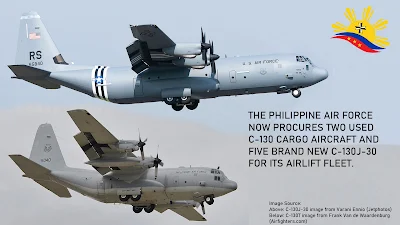 |
| Philippine Air Force's prospects in getting two types of C-130s. |
1. United States
Material Type: C-130H Hercules
Weapons Description: transport aircraft
Number ordered: 2
Year ordered: 2020
Year delivery: 2021-2022
Number delivered: 2
Description: [it is a] second-hand, Php 2.5 Billion ($52 Million) deal, including Php 900 Million ($18 Million) FMF Aid.
2. United States
Material Type: C-130J Hercules
Weapons Description: transport aircraft
Number ordered: 5*
Year ordered: 2022
Year delivery: N/A
Number delivered: N/A
Description: N/A
The Philippine Air Force actually pushes its desires of adding more C-130s into its airlift transport fleet, especially of getting at least three (3), if not five (5) new C-130J-30 Hercules transport aircraft that has stretched fuselage for more cargo capacity than the current ones that the air service branch has in active service.
Adding more C-130s is an essential component not only for the Philippine Air Force’s airlifting operations but also for the other branches of the Armed Forces of the Philippines getting the benefit of quick deployment of both military troops and equipment in bulk in areas of concern across the country,
either it may be a battlefield or an HADR operation. The Philippine Air Force is notable in losing some of its C-130 transport aircraft in several accidents,
with the recent one taking place in Sulu in 2021, when the crash took the lives of forty-seven (47) soldiers and three (3) civilians.
Read more on a related PDA article on the C-130 purchases that the Philippine Air Force took on this link right here.
Cessna 172S ‘Skyhawk’ Trainer Aircraft
1. United States
Material Type: Cessna-172
Weapons Description: trainer/light aircraft
Number ordered: 4
Year ordered: 2021
Year delivery: 2022
Number delivered: 4
Description: [It is a] $2.2 Million aid [through FMF], Cessna-172S version.
The aforementioned aviation items under the SIPRI list are among the other assets that the Armed Forces of the Philippines receive from the United States through a Foreign Military Financing or FMF scheme, and these are light assets that serves as a training platform for the troops to use in order to hone further their skills in aviation.
One of those mentioned is the
Cessna 172S “Skyhawk” trainer/light aircraft, of which the United States government provided at least four brand new units for the
Philippine Navy’s Naval Air Wing (NAW), intended to enhance the capability of naval personnel in training onboard the trainer aircraft before getting onboard surveillance patrol aircraft like the TC-90 King Aircraft that the naval service branch currently has.
Robinson R44 Light Helicopter
1. United States
Material Type: R-44
Weapons Description: Light Helicopter
Number ordered: 3
Year ordered: 2021
Year delivery: N/A
Number delivered: N/A
Description: [It is an] aid [through FMF].
On October 6, 2020, the Philippine Army Aviation ‘Hiraya’ Regiment inducted two
Robinson R44 Raven light training helicopters into service, effectively providing a training platform for the regiment to use prior to using their mainstay helicopter at the time this article gets published, the Messerschmitt-Bolkow-Blohm Bo-105 light utility helicopters.
Meanwhile,
the Philippine National Police received the newly delivered two R44 Raven IIs from Robinson’s longtime dealer Lionair Inc., itself being an outright acquisition rather than a Foreign Military Financing scheme as provided by SIPRPI on their list. Like the ones provided for the Philippine Army’s Aviation ‘Hiraya’ Regiment, the national police force intends to use their helicopter in similar training operations, this time related to gaining skills for the police to do surveillance, patrol, and aerial reconnaissance.
As there are no clear recipient units of the Robinson R44 Light Trainer Helicopters funded under the United States Foreign Military Financing or FMF, it might be safe to say that either the Philippine Army’s Aviation Regiment or the Philippine National Police’s Special Action Force Aviation Unit (SAF-AU) may benefit on this type of support, although it is better to wait for further detailed information regarding these helicopters to come by, at a later date.
Sikorsky S-70i Black Hawk Combat Utility Helicopters
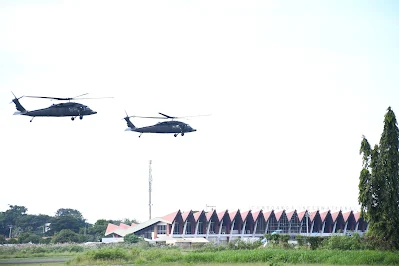 |
| A pair of S-70i Black Hawk Helicopters are flying over Edwin Andrews Airbase. |
1. United States
Material Type: S-70 Black Hawk
Weapons Description: Transport Helicopter
Number ordered: 32
Year ordered: 2022
Year delivery: N/A
Number delivered: N/A
Description: Php 32 Billion ($624 Million) deal, S-70i version, from Polish production line, delivery planned 2023-2026.
To complete the SIPRI list, the Philippine Air Force actually opted for additional S-70i Black Hawk Helicopters, as it will augment the first 16 unit orders of the Combat Utility Helicopters that took place,
with the last batch of deliveries completing the orders in 2021. The units are apparently replacing the older UH-1 Huey Combat Utility Helicopters still in service.
The
contract signing for the 32 S-70i Black Hawk Combat Utility Helicopters took place in February 2022 between the Department of National Defense and the Polish subsidiary of Sikorsky Helicopters PZL Mielec. Adding the 32 follow-up orders over the 16 units already ordered from the same helicopter manufacturer (
with the contract signed in 2019), gives it the total of around 48 S-70i Black Hawk Helicopters that the Philippine Air Force receives for its Combat Utility Helicopter requirements.
The
delivery for the 32 units of Black Hawk Helicopters is about to be accomplished through different batches from 2023 through 2026, with the first delivery coming at five units in 2023. The succeeding delivery comes as follows - ten (10) units in 2024, ten (10) more units in 2025, and a final delivery of seven (7) units in 2026.
Read more on these related PDA articles on the S-70i Black Hawk Helicopters that the Philippine Air Force is about to receive in the following links below.
IN SUMMARY
The list provided by the Stockholm International Peace Research Institute or SIPRI provides an insight about the current progress of several arms transfers to the Armed Forces of the Philippines, and also to the law enforcement agencies like the Philippine National Police, as it gives the whole picture of the number of items that these uniformed services receive within the year 2022.
As we see here, the Philippines has received a lot of military hardware and assets for the year 2022, which makes this list long of at least four landscaped pages, a clear marker regarding the implementation of the Revised AFP Modernization Program under the Republic Act 10349, with most items being the known projects for all the branches involved - the Philippine Army, Philippine Air Force, and the Philippine Navy, with several items not yet discussed in this website in-detail.
Through time, and as the Horizon 3 of the Revised AFP Modernization Program gets rolling, the SIPRI list of the succeeding years may vary, with completed projects expunged from the register and replaced by newly implemented projects that may increase or decrease the items provided in their reports.
(c) 2023 PDA.



